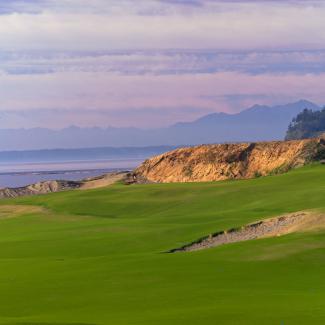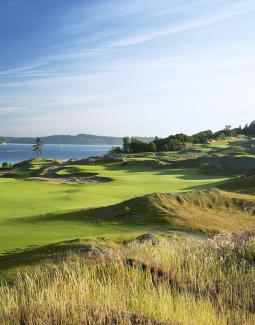Featured Golf News
Winter Prep at Chambers Bay in Full Swing
When they say it's as exciting as watching grass grow, well, at Chambers Bay - the fledging site of the 2015 U.S. Open - they actually mean it. It is exciting, necessary and crucial, and whatever else you want to say about getting the course - especially its greens - ready for the world's best players in June.

Chambers Bay
"The grass is growing like crazy," said USGA agronomist Larry Gilhuly. "Kudos to (Pierce) County for taking the financial hit and KemperSports for devising the program. The best thing is we didn't have to tell them to do anything, they just told us what they were doing."
What they've done at Chambers Bay is remarkable. The course has always had a certain "wow" factor - the views of Puget Sound and the mountains beyond, plus 250 acres of gorgeously-shaped sand dunes. But the course itself has not always been in the best shape, especially the greens, which outside of wind and weather best protect the course from a birdie onslaught.
The greens are big and tumbling and need negotiating. They were never meant to be as fast as they are at many courses in the Pacific Northwest, but offering plenty of challenges with diabolic pin placements.

Chambers Bay Photo with U.S. Open &
Super Bowl Trophies
In fact, one of the reasons Mike Davis, head of the United States Golf Association, said the U.S. Open is being played on such a new and untested course was that it offered one of the few opportunities to play and putt on the turf at Chambers Bay.
"They can be beautiful to putt on," said Davis. "We're excited that the Open will be played, for the first time, on fine fescue grasses."
Wall-to-wall fescue allows a player to putt from 30 yards off the green and be assured the speed of fairways and greens will be relatively the same. But while everyone was excited about the potential for fescue, there was also a reality that the grass strain didn't wear well and that too much foot traffic could damage the greens, which it did.
A year ago, the course was heavily played in January by locals enjoying firm conditions and reduced rates. The greens never really recovered from the play or the weather. So last spring, Matt Allen, the general manager at Chambers Bay, devised a plan that would maximize revenues in the summer - with out-of-town folks paying more than $200 a round - and limit play in the winter.
So far, it has worked beautifully, with the course generating more money that it did a year ago even though starting in November it was open only three days a week and to only 150 players a day.
There was also the use of temporary greens, and in the case of the postcard-pretty, par-3 15th hole, players had their balls tossed back to them after hitting the green, asked to score a ball hit on the putting surface as a par and those hit within 15 feet of the flag to card a birdie.

Chambers Bay with Puget
Sound in Background
(Photo by Aiden Bradley)
Since the very successful U.S. Amateur at Chambers Bay in 2010, the USGA has overseen the rebuilding of five greens - Nos. 1, 4, 7, 10 and 13 - allowing more pin placements, a fairer return for a well-placed shot, and better egress and exit for players.
The seventh and 10th holes were reseeded as late as two years ago. Right now, the only greens of concern are Nos. 10, 12 and 15.
"The off -season plans, coupled with warm temps, are really doing the trick," said Allen. "A couple of spots on No. 12 and No. 15 will need to be protected through March, but much of the greens are in peak season conditions . . . and it's January!
"I am very energized and have such a high degree of confidence about how the course will be in June. Now, we'll just keep our fingers crossed for a dry month of May."
Besides limiting play, Pierce County also approved the purchase of tarps for covering each of the greens; they're used when temperatures tumble toward freezing. Along the way, continual testing of conditions revealed that soil temperatures were 8 degrees lower at Chambers Bay than at the all-fescue Bandon Dunes on the Southern Oregon coast.
"They have done everything right in regard to growing grass this winter," noted Gilhuly. "The use of covers, limiting play, keeping traffic completely off Nos. 10, 12 and 15 has resulted in near-100 percent recovery on these three greens. The remaining greens have the most grass I have ever seen in the winter. Things look great in my agronomic opinion."
Allen said the restricted play will likely last through March, and although there will be more play in May it will still be half of what it was the year before.
The goal is long-range: Chambers Bay hopes to be included in a rotation of American courses for the Open, perhaps seeing the event every 10 years or so. There was simply no room for short-term thinking. And, thankfully, there wasn't any.
Blaine Newnham has covered golf for 50 years. He still cherishes the memory of following Ben Hogan for 18 holes during the first round of the 1966 U.S. Open at the Olympic Club in San Francisco. He worked then for the Oakland Tribune, where he covered the Oakland Raiders during the first three seasons of head coach John Madden. Blaine moved on to Eugene, Ore., in 1971 as sports editor and columnist, covering the 1972 Olympic Games in Munich. He covered five Olympics all together - Mexico City, Munich, Los Angeles, Seoul, and Athens - before retiring in early 2005 from the Seattle Times. He covered his first Masters in 1987 when Larry Mize chipped in to beat Greg Norman, and his last in 2005 when Tiger Woods chip dramatically teetered on the lip at No. 16 and rolled in. He saw Woods' four straight major wins in 2000 and 2001, and Payne Stewart's par putt to win the U.S. Open at Pinehurst. In 2005, Blaine received the Northwest Golf Media Association's Distinguished Service Award. He is the author of the book, "America's St. Andrews," which tells the colorful back-story of how Chambers Bay was selected as the site of the 2015 U.S. Open. The book was released October 1, 2014, and may be ordered at www.AmericasStAndrews.com. He and his wife, Joanna, live in Indianola, Wash., where the Dungeness crabs outnumber the people.
Story Options
 |
Print this Story |
